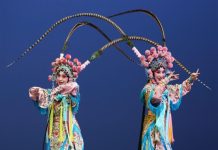BEIJING: The Winter Olympics will turn 100 in 2024 and over the past 98 years, skiing has been an integral part of the Olympic Winter Games. Among the 109 events in the Olympic Winter Games Beijing 2022, more than half relate to skiing.
“The Beijing 2022 Games feature the largest number of skiing events ever,” Shan Zhaojian, China’s first national skiing champion and torchbearer of the Games, told Beijing Review.
Man’s foray into skiing
The 84-year-old is not only a veteran skiing pro, but also an expert on the activity’s historical research. In 2005, he was the first to identify the earliest known evidence of humans skiing in Altay Prefecture, Xinjiang Uygur Autonomous Region. His findings were recognized by international historians at a global forum in Altay in January 2015, six months before Beijing won the bid to host the 2022 Olympic Winter Games. And Altay is recognized as the earliest known source of human skiing activities.
Altay, located at the northwestern tip of China, comes with a six-month-long snow season. In the 1990s, Shan, then Secretary General of the Chinese Ski Association and Director of the Ski Department of the General Administration of Sport of China, visited the region frequently.
He found that a fur-covered ski, called chana, was still being used by rural residents as a basic way of transportation in some parts of Altay. Handmade from horsehair and wood, the skis bear leather ropes that serve as its bindings. “When going uphill, the horsehair brushes against the ground, creating great friction to prevent any backslide. When coming down, the hairs smoothen over, enabling the skier to slide down,” Shan explained.
The traditional skiing gear also comes with a multi-functional wooden pole, which served as a hunting tool back in the day. Hunters could use it as a spear when spotting prey; thinner wooden poles could act as a bow, by bending them.
The way Altay rural residents used their fur-covered skis was vividly reminiscent of a particular record documented in The Classic of Mountains and Seas, a work of folk geography in ancient China written roughly 2,000 years ago. Could Altay possibly be the origin of human skiing activities? Shan was determined to find out.
Following his retirement in 1998, Shan teamed up with local archaeologists to trace the origins of skiing. In 2005, he was told that a painting had been uncovered inside a cave in Handegate Township, Altay, and the depicted figures looked like they were skiing.
“There were red images of oxen, horses and humans across the wall of the cave; the color was very bright,” Ou Jisheng, a 55-year-old farmer who first discovered the painting by accident when he was 15, told Beijing Review. For more than two decades, except for his father, Ou had told no one about his discovery until 2003, when he told a local official and the finding came into the spotlight.
With the guidance of Ou and the local official, Shan visited the cave in March 2005. Shan was “extremely excited” upon first seeing the painting. Ten human-shaped figures, with short poles in their hands and board-shaped objects under their feet, stand in line. Their upper bodies lean forward, with their heads raised up and their hips and knees bent equally. Below them are images of oxen, horses, deer, and boars. Shan took some photos and brought them back to Beijing, inviting skiing experts to analyze the figures. They agreed that the figures’ movements align with the posture of a skier. Further archaeological analysis later found that the painting dates back at least 10,000 years.
According to Shan, the painting is only part of the historical evidence proving Altay to be the earliest known origin of man’s skiing activities. Chanas aside, a centuries-old folk song that tells of how hunters went skiing in the forests is still sung by local communities to this very day.
According to Shan, skiing was the best option for ancient Altay hunters to get around. Located at a latitude similar to that of the Alps, the region has a snow season of 179 days and is dotted with mountains. What’s more, 22.65 percent of its land is covered by forest, offering abundant wood for crafting skis and hunting game.
Due to rising environmental protection awareness, the residents of Altay no longer live off hunting, but the fur-covered skis are still in use. “Today, it is a tool for entertainment and a driver for local tourism,” Shan said. Every January 16, a fur ski competition is held in Altay to commemorate the origin of skiing in Xinjiang.
On March 23, 2018, the International Skiing History Association awarded Shan with the Lifetime Achievement Award for his research on ski culture and history, making him one of only two people in the world to have received this honor. -The Daily Mail-Beijing Review News Exchange Item






